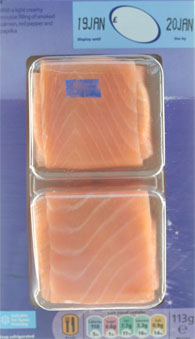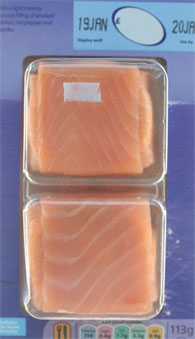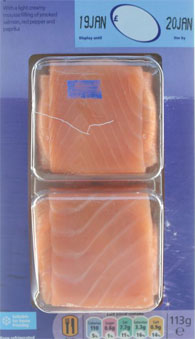| Posted: Jan 17, 2008 | |
Intelligent inks - now you see them, now you don't |
|
| (Nanowerk Spotlight) Most people when they hear the word semiconductor will think about their role in computers. However, semiconductors also absorb light, some absorb in the visible, thus appearing colored, e.g. gray silicon, and others in the UV, such as titanium dioxide, thus appearing white (when in microparticulate form) or colorless (when in nanoparticulate form). This light-absorbing feature is used to drive electrons around a circuit in photovoltaic cells, such as the silicon solar cell, but it can also be used to drive chemical reactions at the surface. A good example of the latter is the use of thin (15 nm) titanium dioxide film coatings on self-cleaning glass. These films upon absorbing UV light in sunlight are able to reduce oxygen, present in air, to water and oxidize any organic material on its surface to its minerals, thereby keeping the surface clean. Researchers in the UK have used this oxidation feature to developed an irreversible solvent-based blue ink, which upon activation with UV light, loses all its color and becomes oxygen sensitive; it will only gain its original color upon exposure to oxygen. A major application area for this oxygen ink is in food packaging where it could be used to detect a modified atmosphere inside food containers. | |
| Oxygen is an essential feature of respiration in most organisms and, as such, is a key element in life – but it is also the main reason for food spoilage, not only because it can react chemically with food, but also because its presence is essential for the growth of moulds and other aerobic micro-organisms. | |
| The food industry has therefore developed a preservation technique used to prolong the shelf life of processed or fresh food by changing the composition of the air surrounding the food in the package. Called Modified Atmosphere Packaging (MAP), this technique reduces the oxygen content within the package by either completely flushing out the air and replacing it with nothing (as in vacuum packaging) or with another gas composition containing nitrogen or carbon dioxide. MAP has become widely used and already over 50 billion food packages were MAPed in 2007. | |
| Commercial color-indicator oxygen sensors are available, of course, but the reason you still can't find them on your MAP packaged meat or fish is that they require the use of expensive equipment and a trained operator, they are not inks and therefore not readily printed, they are not easily handled or stored (since they are active all the time and fail after long exposure to oxygen), and as a result are too expensive as routine indicators for everyday food packaging in supermarkets. | |
| "In our UV activated, oxygen sensitive ink, titania nanoparticles upon exposure to a short burst of UV light are able to oxidize an organic in the ink and simultaneously reduce a dye that is also present" Dr. Andrew Mills tells Nanowerk. "This redox dye is highly colored in its original (oxidized) form) but colorless in its reduced form. Most importantly, the latter is also oxygen sensitive. So that upon UV activation the highly colored ink bleaches and is oxygen sensitive, only regaining its color upon exposure to air." | |
| Mills, a professor in the Department of Pure & Applied Chemistry, and James Young Chair in Chemistry, at the University of Strathclyde in Glasgow, UK, explains that for the greatest flexibility, such a functional ink (some people prefer the title intelligent ink) needs to be printable on plastics and so requires to be solvent, rather than water, based. He and his team therefore have made sure all the components are solvent (ethanol) compatible. | |
| The result is the first UV-activated, color ink that is oxygen sensitive and so can be used for qualitative and quantitative analysis. These inks have indefinite storage times – they do not function as oxygen indicators until and unless they are exposed to UV activating light – and are made from very inexpensive components. | |
   |
|
| Photographs of oxygen indicator ink printed on a MAPed food package. Left: Before UV activation. Middle: After UV activation. Right: On opening the package. (Photographs: David Hazafy, University of Strathclyde) | |
| The traditional role of ink in food packaging has been that of a passive communicator of information: ingredients, instructions, sell-by dates and so on. Now, with intelligent inks, this role is changing and they become reactive, being able to change information based on their response to a change of the substrate they are applied to or the environment that surrounds them. | |
| "I have worked on a wide range of functional inks not only because they are fun to work with and present great challenges, but also because there is an increasing need and interest in information, especially if it is inexpensive" Mills describes the motivation for his work. "Everybody would like to be more informed. These functional inks can provide a wealth of information, accessible to most people, especially if color (rather than luminescence) based inks are used, since colors are usually easy to assess." | |
| Mills explains the basic working principles of such an irreversible oxygen indicator, based on the light absorbance feature of semiconductors: Upon irradiation with UVA light, ultra-bandgap illumination of the TiO2 particles creates electron?hole pairs. The photo-generated holes, h+, oxidize the mild sacrificial electron donor glycerol to glyceraldehyde. The remaining photo-generated electrons, i.e. TiO2? reduce the redox-sensitive dye, DOx (in Mill's work this is methylene blue), to a reduced form, DRed (leuco-methylene blue) that has a different color to DOx. These key components are encapsulated in a polymer, usually hydroxyethyl cellulose (HEC), to create an oxygen-sensitive, UV-activated film. | |
| "All these components are readily dissolved or dispersed in water to create an intelligent, water-based ink for oxygen" says Mills. "The major drawback of this indicator is the hydrophilic, water-soluble nature of the ink, which limits its applications, especially in food packaging, since it is difficult to print such an ink on the mostly hydrophobic plastics used in packaging, such as polypropylene (PP), poly(ethylene terephthalate) (PET) or nylon. In our paper ("A solvent-based intelligence ink for oxygen") we describe the preparation and characterization of a colorimetric, UV-activated solvent-based intelligent ink for oxygen, that readily wets and prints onto such plastics." | |
| A major application of this new ink can be found in the quality assurance in MAP packaging. Although an increasing number of food is now MAPed, the quality assurance is not 100%. Given the huge number of items it is not possible to check if every package is properly sealed - and then even after it has been checked it could break in transit or through customer handling on the shelf. | |
| The oxygen indicator inks developed by Mills could be used to provide 100% quality assurance not only to the packager, but also retailer and customer – reassuring all that the package is intact and the food is safe to eat. | |
| Apart from food packaging, cheap and inexpensive ink sensors could find a wide range of applications. "There are still many analytes that would benefit from routine monitoring via printable inks, such as food spoilage gases, hydrogen peroxide, water, carbon monoxide - the list is long!" says Mills. | |
 By
Michael
Berger
– Michael is author of three books by the Royal Society of Chemistry:
Nano-Society: Pushing the Boundaries of Technology,
Nanotechnology: The Future is Tiny, and
Nanoengineering: The Skills and Tools Making Technology Invisible
Copyright ©
Nanowerk LLC
By
Michael
Berger
– Michael is author of three books by the Royal Society of Chemistry:
Nano-Society: Pushing the Boundaries of Technology,
Nanotechnology: The Future is Tiny, and
Nanoengineering: The Skills and Tools Making Technology Invisible
Copyright ©
Nanowerk LLC
|
Become a Spotlight guest author! Join our large and growing group of guest contributors. Have you just published a scientific paper or have other exciting developments to share with the nanotechnology community? Here is how to publish on nanowerk.com.
